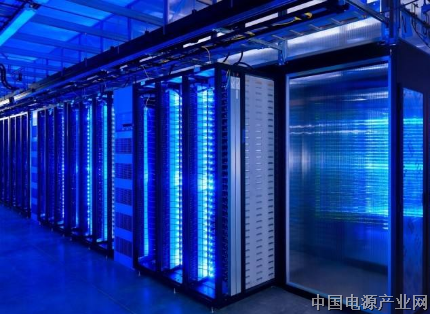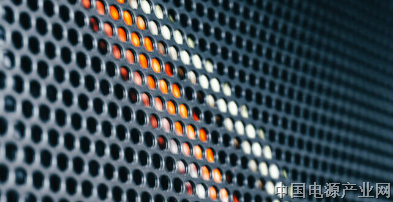专为冷却数据中心而开发的两相混合系统
2024-10-18
中国电源产业网

导语:随着人工智能需求的快速增长,数据中心承载的计算任务日益繁重,产生了大量的热量,冷却系统消耗了数据中心高达40%的能源。为应对这一挑战,密苏里大学的科研人员Chanwoo Park领导了一项由ARPA-E资助的COOLERCHIPS中的子项目,该项目旨在开发一种创新的混合两相循环冷却系统,该系统具备根据实际负载情况自动调整系统主被动运行模式的功能,以更高效、更节能的方式为数据中心提供冷却解决方案。

为高效冷却数据中心而开发的两相混合系统
Two-phase hybrid system developed to efficiently cool data centers
BY UNIVERSITY OF MISSOURI FEBRUARY 20, 2024
● 译者说
随着人工智能需求的快速增长,数据中心承载的计算任务日益繁重,产生了大量的热量,冷却系统消耗了数据中心高达40%的能源。为应对这一挑战,密苏里大学的科研人员Chanwoo Park领导了一项由ARPA-E资助的COOLERCHIPS中的子项目,该项目旨在开发一种创新的混合两相循环冷却系统,该系统具备根据实际负载情况自动调整系统主被动运行模式的功能,以更高效、更节能的方式为数据中心提供冷却解决方案。
密苏里大学工程学院科研人员设计了一种两相混合系统来更高效、更有效地冷却数据中心。
A Missouri Engineering researcher devised a system to cool data centers down more efficiently and effectively with a two-phase hybrid system.

对人工智能需求的不断增长给服务于 AI 的数据中心带来能源压力。大量的计算活动产生了巨大的热量——以至于冷却系统占用了数据中心40%的能耗。这(耗能)相当于为 32,000 个家庭供电。
The demand for artificial intelligence is rising, which is putting energy strains on the data centers that power the technology. And that massive computational activity generates a tremendous amount of heat—so much so that cooling systems account for up to 40% of the energy used in data centers. That’s the equivalent of powering some 32,000 households.
目前,密苏里大学工程学院科研人员正在设计一种更高效的数据中心冷却系统。Chanwoo Park 正在管理一个由美国能源部高级能源计划研究署(Advanced Research Projects Agency-Energy ARPA-E) 资助的项目并与国家可再生能源实验室合作。这个项目是耗资 4000 万美元的计划COOLERCHIPS的一部分,COOLERCHIPS (Cooling Operations Optimized for Leaps in Energy, Reliability and Carbon Hyperefficiency for Information and Processing Systems))全称为“实现信息处理系统的能源、可靠性和碳效率飞跃的优化冷却技术”。
Now, a Mizzou Engineering researcher is devising a system to cool data centers down more efficiently and effectively. Chanwoo Park is leading a project funded by the U.S. Department of Energy’s Advanced Research Projects Agency-Energy (ARPA-E) in collaboration with the National Renewable Energy Lab. It’s part of a $40 million endeavor called COOLERCHIPS, which stands for Cooling Operations Optimized for Leaps in Energy, Reliability and Carbon Hyperefficiency for Information and Processing Systems.
密苏里大学机械和航空航天工程副教授 Park 是这项耗资 160 万美元的项目的首席研究员,该项目旨在开发一种混合两相回路,作为数据中心冷却解决方案。
Park—an associate professor of mechanical and aerospace engineering—is the Principal Investigator of a $1.6 million project to develop a hybrid two-phase loop to serve as a cooling solution for data centers.
“我对此感到自豪,因为多年来我们一直在开发这项技术,” Park说。“ARPA 的资助给了我们许多资源来解决问题,并允许我们与国家实验室和行业合作。”
“I’m proud of this because we’ve been developing our technology over many years,” Park said. “This ARPA award gives us a lot of resources to solve the problem and allows us to work with the national lab and industry.”
数据中心的传统冷却方式是使用强迫对流风机或通过液体流动将热量从存放计算机处理器的机架中带走。这两种过程都存在问题,因为它们需要大量的电能和水资源。
Traditionally, data centers have been cooled using air-moving fans or by flowing liquid to move heat away from the racks that hold computer processors. Both processes are problematic in that they suck up enormous amounts of energy and water resources.
Park的解决方案(两相冷却技术)有主动和被动两种模式,这意味着冷却系统可以根据(数据中心)冷却需求来实现被动或主动运行。
Park’s method has an active and passive mode, meaning the cooling system can run either passively or actively depending on cooling requirements.
“如果计算机处于闲置状态,(它的)冷却需求是最小的,在这种情况下,(冷却)系统将进入被动模式,”他说。“我们不使用像泵这样的主动器件,所以不会消耗能源。当计算机开机并提高运行负载,此时需要提高冷却能力,它(冷却系统)就会切换到主动模式,开启水泵。”。这就像现代汽车——当你在红绿灯前停车时,发动机会停止,这样就不会耗油。当你再次加速时,发动机就会再次自动启动。
“If a computer is idling, the cooling demand is minimal, and in that case, the system goes into passive mode,” he said. “We don’t use active components like pumps so there’s no energy consumption. When a computer turns on and is running harder, requiring more cooling, it switches to active mode, turning on the pump. This is like modern cars—when you stop at a light, the engine stops so there’s no fuel consumption. When you accelerate again, the engine automatically turns back on.”
混合(冷却)设计还集成了毛细管和机械泵送。在蒸发器内,毛细结构产生能够蒸发的薄液体层,从而以最小的热阻实现服务器芯片高效散热。同时,机械泵送通过高效吸收大量热量来增强冷却能力。
The hybrid design also integrates capillary pumping with mechanical pumping. Within the evaporator, the capillary structure generates thin liquid layers capable of evaporating to efficiently dissipate heat from server chips with minimal thermal resistance. Simultaneously, mechanical pumping enhances cooling capacity by efficiently absorbing a substantial amount of heat.
“通过使用该混合(冷却)设计,我们正为数据中心创造理想的冷却解决方案”Park说,“这(理想冷却解决方案的开发)非常困难,需要大量的分析和制造工作。它(混合冷却设计)涉及先进的制造技术,设计目的是处理高(热)流量,并可以在扩展到大系统的同时保持低功耗。它非常接近我们在寻找的理想冷却系统。
“Using this hybrid design, we are creating an ideal cooling solution for data center cooling,”Park said. “It’s very difficult, and it requires a lot of analysis and a lot of fabrication. It involves advanced manufacturing techniques, but it is designed to handle high flux and can scale up to very large systems with low power consumption. It’s very close to the ideal cooling system we’re looking for.”
“通过使用该混合(冷却)设计,我们正为数据中心创造理想的冷却解决方案”Park说,“这(理想冷却解决方案的开发)非常困难,需要大量的分析和制造工作。它(混合冷却设计)涉及先进的制造技术,设计目的是处理高(热)流量,并可以在扩展到大系统的同时保持低功耗。它非常接近我们在寻找的理想冷却系统。
Park is five months into the three-year project. Ultimately, the goal is to find a system that can be commercialized and mass-produced for use in high-end data centers. He’s optimistic that the partnership with government and industry will result in large-scale commercialization.
“多亏与国家实验室和行业同仁的合作,我们取得了重大进展,”Park 说,他强调这已经达到初步里程碑。“最后,我看好这种冷却系统,(它)将被数据中心所采用,以提高整体效率。”
“Thanks to collaboration with national labs and industry partners, we’re making significant strides,” Park said, highlighting the successful achievement of initial milestones. “Ultimately, I’m optimistic that this cooling system will be adopted by data centers to enhance overall efficiency.”
● 翻译:
章子寒
科华数据股份有限公司 制冷工程师
DKV(DeepKnowledge Volunteer)计划成员
● 校对:
贾梦檩
DKI(DeepKnowledge Intelligence)高级研究员
编辑:中国电源产业网
来源:《电源工业》编辑部
标签:
下一篇:数据中心配电架构综述
相关信息
MORE >>-
中企助力莫桑比克纳卡拉走廊物流体系全面提升
在莫桑比克纳卡拉旧港煤码头的施工区域,一组新的测量点位正在布设。中铁二十局测量员奥兰多扛着实时动态测量仪器走入现场,将设备稳稳立在标定位置,逐项完成校准、定位和记录。这些数据将为工程下一阶段施工提供基础支撑。
-
数据中心配电架构综述
本文以浅显易懂的方式概述了数据中心对电力的需求、电力的来源、如何将电力分配至数据中心并传输至各末端设备、哪些环节需要用电、用电量多少、如何合理用电以及冗余系统的作用和方式。相信读者阅读后,能够对数据中心的电力分配建立整体的认知。
-
欧盟对华电动汽车反补贴调查终裁披露,多方回应
8月20日,作为其正在进行的反补贴调查的一部分,欧盟委员会向相关方披露了对从中国进口的电池电动汽车(bev)征收最终反补贴税的决定草案。
-
涉及稀土,“欧洲重大发现”
挪威稀土公司宣布,该公司发现了欧洲大陆最大的稀土矿。
-
深入了解微软悉尼西区中断事件
随着数据中心自动化水平的提高,用户本能希望可以确保其数据的可用性无限接近100%,且会询问是否有足够多的数据中心员工来实现较高水平的正常运行时间。即当发生潜在的中断风险时,有足够的技术人员当班或可响应以便尽快恢复服务。
-
“出轨”+“泄漏”!美国又摊事了!
最近一段时间,美国火车脱轨事故频繁发生。3月15日至16日,又有至少四列火车脱轨。其中,3月16日发生在华盛顿州的火车脱轨事故造成柴油泄漏,污染土壤。









 中国电源产业网网友交流群:2223934、7921477、9640496、11647415
中国电源产业网网友交流群:2223934、7921477、9640496、11647415